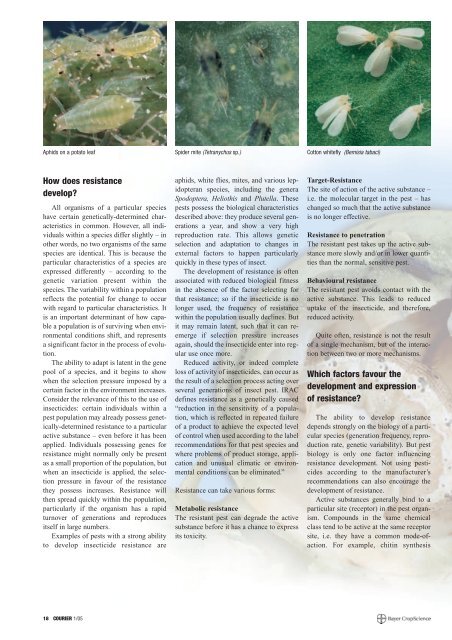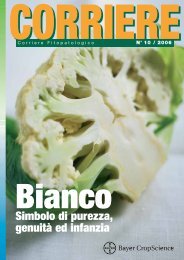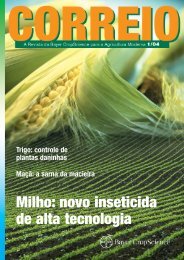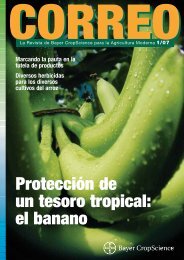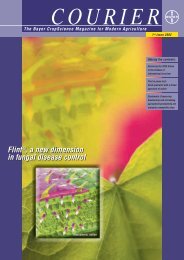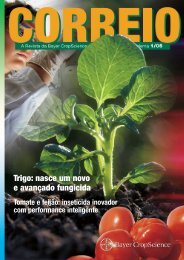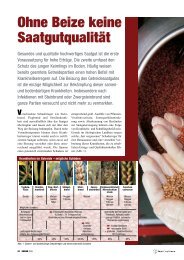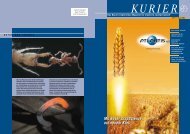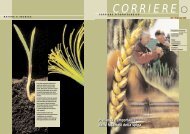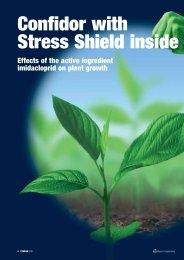Maize: the gift of the gods
Maize: the gift of the gods
Maize: the gift of the gods
- No tags were found...
Create successful ePaper yourself
Turn your PDF publications into a flip-book with our unique Google optimized e-Paper software.
Aphids on a potato leaf Spider mite (Tetranychus sp.) Cotton whitefly (Bemisia tabaci)How does resistancedevelop?All organisms <strong>of</strong> a particular specieshave certain genetically-determined characteristicsin common. However, all individualswithin a species differ slightly – ino<strong>the</strong>r words, no two organisms <strong>of</strong> <strong>the</strong> samespecies are identical. This is because <strong>the</strong>particular characteristics <strong>of</strong> a species areexpressed differently – according to <strong>the</strong>genetic variation present within <strong>the</strong>species. The variability within a populationreflects <strong>the</strong> potential for change to occurwith regard to particular characteristics. Itis an important determinant <strong>of</strong> how capablea population is <strong>of</strong> surviving when environmentalconditions shift, and representsa significant factor in <strong>the</strong> process <strong>of</strong> evolution.The ability to adapt is latent in <strong>the</strong> genepool <strong>of</strong> a species, and it begins to showwhen <strong>the</strong> selection pressure imposed by acertain factor in <strong>the</strong> environment increases.Consider <strong>the</strong> relevance <strong>of</strong> this to <strong>the</strong> use <strong>of</strong>insecticides: certain individuals within apest population may already possess genetically-determinedresistance to a particularactive substance – even before it has beenapplied. Individuals possessing genes forresistance might normally only be presentas a small proportion <strong>of</strong> <strong>the</strong> population, butwhen an insecticide is applied, <strong>the</strong> selectionpressure in favour <strong>of</strong> <strong>the</strong> resistance<strong>the</strong>y possess increases. Resistance will<strong>the</strong>n spread quickly within <strong>the</strong> population,particularly if <strong>the</strong> organism has a rapidturnover <strong>of</strong> generations and reproducesitself in large numbers.Examples <strong>of</strong> pests with a strong abilityto develop insecticide resistance areaphids, white flies, mites, and various lepidopteranspecies, including <strong>the</strong> generaSpodoptera, Heliothis and Plutella. Thesepests possess <strong>the</strong> biological characteristicsdescribed above: <strong>the</strong>y produce several generationsa year, and show a very highreproduction rate. This allows geneticselection and adaptation to changes inexternal factors to happen particularlyquickly in <strong>the</strong>se types <strong>of</strong> insect.The development <strong>of</strong> resistance is <strong>of</strong>tenassociated with reduced biological fitnessin <strong>the</strong> absence <strong>of</strong> <strong>the</strong> factor selecting forthat resistance; so if <strong>the</strong> insecticide is nolonger used, <strong>the</strong> frequency <strong>of</strong> resistancewithin <strong>the</strong> population usually declines. Butit may remain latent, such that it can reemergeif selection pressure increasesagain, should <strong>the</strong> insecticide enter into regularuse once more.Reduced activity, or indeed completeloss <strong>of</strong> activity <strong>of</strong> insecticides, can occur as<strong>the</strong> result <strong>of</strong> a selection process acting overseveral generations <strong>of</strong> insect pest. IRACdefines resistance as a genetically caused“reduction in <strong>the</strong> sensitivity <strong>of</strong> a population,which is reflected in repeated failure<strong>of</strong> a product to achieve <strong>the</strong> expected level<strong>of</strong> control when used according to <strong>the</strong> labelrecommendations for that pest species andwhere problems <strong>of</strong> product storage, applicationand unusual climatic or environmentalconditions can be eliminated.”Resistance can take various forms:Metabolic resistanceThe resistant pest can degrade <strong>the</strong> activesubstance before it has a chance to expressits toxicity.Target-ResistanceThe site <strong>of</strong> action <strong>of</strong> <strong>the</strong> active substance –i.e. <strong>the</strong> molecular target in <strong>the</strong> pest – haschanged so much that <strong>the</strong> active substanceis no longer effective.Resistance to penetrationThe resistant pest takes up <strong>the</strong> active substancemore slowly and/or in lower quantitiesthan <strong>the</strong> normal, sensitive pest.Behavioural resistanceThe resistant pest avoids contact with <strong>the</strong>active substance. This leads to reduceduptake <strong>of</strong> <strong>the</strong> insecticide, and <strong>the</strong>refore,reduced activity.Quite <strong>of</strong>ten, resistance is not <strong>the</strong> result<strong>of</strong> a single mechanism, but <strong>of</strong> <strong>the</strong> interactionbetween two or more mechanisms.Which factors favour <strong>the</strong>development and expression<strong>of</strong> resistance?The ability to develop resistancedepends strongly on <strong>the</strong> biology <strong>of</strong> a particularspecies (generation frequency, reproductionrate, genetic variability). But pestbiology is only one factor influencingresistance development. Not using pesticidesaccording to <strong>the</strong> manufacturer’srecommendations can also encourage <strong>the</strong>development <strong>of</strong> resistance.Active substances generally bind to aparticular site (receptor) in <strong>the</strong> pest organism.Compounds in <strong>the</strong> same chemicalclass tend to be active at <strong>the</strong> same receptorsite, i.e. <strong>the</strong>y have a common mode-<strong>of</strong>action.For example, chitin syn<strong>the</strong>sis18 COURIER 1/05


